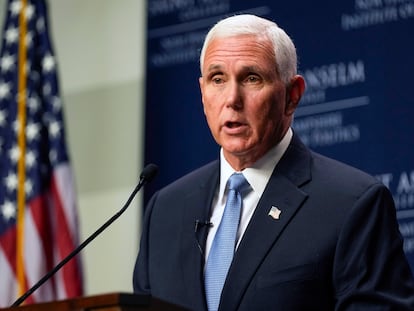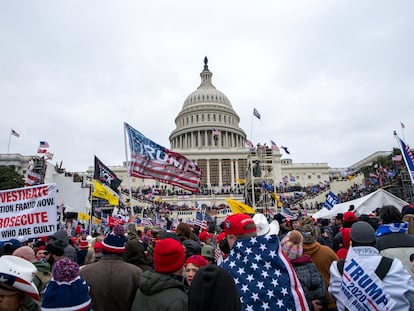Stormy Daniels case: How 12 jurors were ‘cast’ in the ‘People vs Trump’
The first week of the criminal trial against the former U.S. president went according to schedule. The two sides will present their opening arguments on Monday


Thursday, the third day of jury selection in the Stormy Daniels case against Donald Trump, began with seven confirmed jurors. The seven had been chosen to hear the first criminal case against the former president on Tuesday (there is recess every Wednesday) after dozens were excused the previous day over fears they would not be impartial. However, the seven jurors suddenly became five after two of them were abruptly removed. But within minutes, the number had risen to 13: the full 12-member jury and the first of the six alternates.
On Friday, the full jury was chosen, with the 18 New Yorkers selected in a timely manner, according to schedule. The pace of the first week of the trial was similar to that of Fast & Furious: it went by in a rush, with sudden breaking, tire screeching and even spins. A whirlwind in which there was no shortage of signs of Trump’s contempt for the process. The former president dozed off on Monday, and on Thursday, he complained about the arctic cold in the room.
A young woman, known only as “Juror Two” — who was selected to be one of the main members of the jury on Tuesday — had second thoughts on Thursday, after receiving a flurry of calls from friends and family who instantly recognized her from the media’s descriptions of the jurors. The jurors’ identity cannot be revealed, but their answers to the in-depth questionnaire used for jury selection provided hints to who they are. Amid the attention, the young woman panicked and argued that she could no longer be impartial. Another jury was excused by Judge Juan Merchan after possible inconsistencies in his answers about his background were flagged — a win for Trump’s defense.
Jury selection is part of the “casting” of the blockbuster case, The People vs. Trump. Although their anonymity is protected, the prospective jurors appeared in front of the entire courtroom, two inches from Trump and his lawyers. And journalist have reported on their approximate age, main physical characteristics, as well as details such as how pets and children they have, their place of work and their neighborhood — information that could provide enough clues to identify them.
This information was not offered freely by the individuals in the 500-plus jury pool, who were examined in groups of 96, but rather revealed in their responses to the 43-question selection questionnaire. This document asked the prospective jurors questions such as whether they belonged to an association (including a neighborhood association); had previously been sworn in a jury; know someone in the security forces, including prison officials, or if someone close to them, or they themselves, have been convicted. “Yes, I have several close friends who are criminals,” one candidate declared on Friday.
The U.S. judicial system — the inspiration of so many good courtroom dramas — is testing its strength and flexibility in this historic case, stemming from hush money paid to porn actress Stormy Daniels to cover up an alleged extramarital affair. The process may be the same, but the defendant is unprecedented: Trump is the first former U.S. president to stand trial. He is also the Republican candidate for the presidential election in November. It is rare for a juror to be eliminated after being sworn in, regardless of how much information is found out afterward. Social media scrutiny has been decisive. As have the attention and media pressure, as demonstrated by “Juror Two’s” concern.
But Judge Merchan has been both firm and kind, even empathetic. This was seen on Friday, when a woman burst into tears after acknowledging her history of drug use. Merchan and his team literally shielded her to protect her from the stares in the courtroom — especially Trump’s penetrating gaze — while the woman explained the shame of sharing that dark chapter of her life in front of 150 people. Prosecutor Susan Hoffinger reminded candidates on Friday what the job of a jury entails: “It’s not about who you’re going to vote for in the fall,” she warned. A woman who said she attended the Women’s March against the Republican presidency said that her criticism of Trump for his racist or homophobic comments would not compromise her impartiality: “That is an issue that will have to resolve at the polls, not in the courts.”
Among the potential jurors, a sound technician offered his services to the court in case the microphones stopped working and a woman with anxiety said she was unable to cope with the case. One of the candidates chosen told the court he thought Trump was “fascinating and mysterious.” The names of the jurors cannot be revealed, and initially Merchan did not impose any other restriction on how the media could report on the case. However, after “Juror Two” was excused after being easily identified by her friends and family, the judge ordered the journalists present in the room not to report on their current and previous workplaces, physical appearance or accents.
Rules on court reporting
Rules limiting media coverage in the courtroom date back nearly a century, when witnesses in the 1935 trial of the man accused of kidnapping and killing of aviator Charles Lindbergh’s young son were met with bright flashbulbs and camera operators — a spectacle that horrified the legal community. New York law prohibits trials from being broadcast. It did allow them to be televised on an experimental basis between 1987 and 1997, but this stopped amid pressure from authorities.
Although the trial cannot be filmed, Merchan will allow a handful of photographers to take photos of Trump sitting among his lawyers before the day’s proceedings begin. But when the hearing starts, only the courtroom artists are allowed to stay.
The only live footage is provided by a closed circuit television that broadcasts from the main room to the adjacent one, filled mostly with journalists but also some individuals. Only those who wake up very early are able to arrive in time to enter.
The simple fact that Trump is present during jury selection has also had an impact on the possible jurors. One woman became so nervous on Friday after meeting the defendant’s gaze that she began to chew on the corner of the card they give to those summoned (with a letter and a number). For others, however, Trump is a familiar part of the New York landscape: judging him is like judging the Manhattan skyline and the glitz of the luxury of the 1980s and 1990s, when the tycoon was a key figure in Manhattan parties and, as a real estate developer, shaped the very image of the city to his person, with Trump Tower becoming a New York icon.
Trump’s constant comments about the case (he is accused of violating the court’s gag order seven times), as well as the campaigns led by his supporters online and in conservative media such as Fox, have raised important concerns about security: it is no longer just a matter of maintaining the jurors’ anonymity, but also their safety. Indeed, jury selection has almost been an extreme sport, with the possible jurors faced with the challenge of having to balance their convictions, the need to remain impartial and the visceral reaction Trump can provoke. Each side was given 10 preliminary strikes that could be used to excuse jurors without cause. The defense used them up quickly, but the prosecution was more lenient when it came to dismissing possible jurors. With the full jury chosen, the trial will move on to the second phase, with opening argument scheduled for Monday.
Sign up for our weekly newsletter to get more English-language news coverage from EL PAÍS USA Edition
Tu suscripción se está usando en otro dispositivo
¿Quieres añadir otro usuario a tu suscripción?
Si continúas leyendo en este dispositivo, no se podrá leer en el otro.
FlechaTu suscripción se está usando en otro dispositivo y solo puedes acceder a EL PAÍS desde un dispositivo a la vez.
Si quieres compartir tu cuenta, cambia tu suscripción a la modalidad Premium, así podrás añadir otro usuario. Cada uno accederá con su propia cuenta de email, lo que os permitirá personalizar vuestra experiencia en EL PAÍS.
¿Tienes una suscripción de empresa? Accede aquí para contratar más cuentas.
En el caso de no saber quién está usando tu cuenta, te recomendamos cambiar tu contraseña aquí.
Si decides continuar compartiendo tu cuenta, este mensaje se mostrará en tu dispositivo y en el de la otra persona que está usando tu cuenta de forma indefinida, afectando a tu experiencia de lectura. Puedes consultar aquí los términos y condiciones de la suscripción digital.
More information
Archived In
Últimas noticias
Most viewed
- Sinaloa Cartel war is taking its toll on Los Chapitos
- Reinhard Genzel, Nobel laureate in physics: ‘One-minute videos will never give you the truth’
- Oona Chaplin: ‘I told James Cameron that I was living in a treehouse and starting a permaculture project with a friend’
- Why the price of coffee has skyrocketed: from Brazilian plantations to specialty coffee houses
- David King, chemist: ‘There are scientists studying how to cool the planet; nobody should stop these experiments from happening’










































